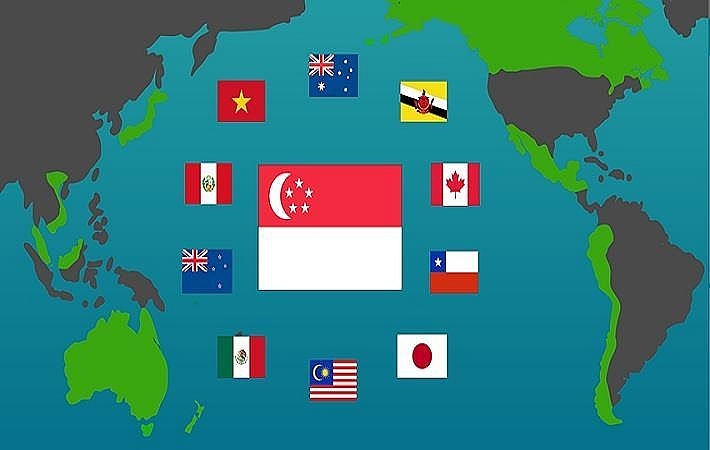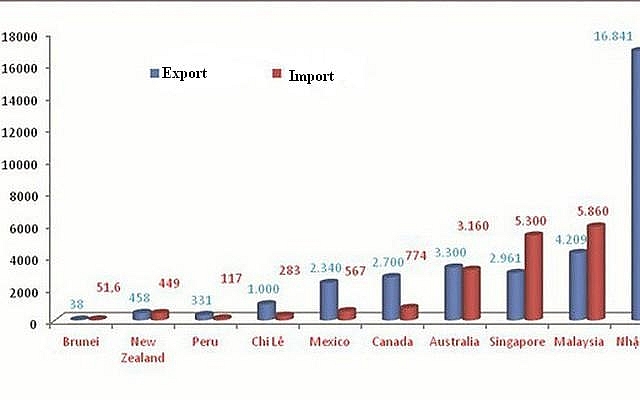CPTPP to widen Vietnam’s inroads to partner markets
 |
| Malaysia, Singapore, Australia, Canada, Mexico, and Chile are six CPTPP billion-dollar partners of Vietnam |
Japan captures huge portion of export-import turnover
Japan is Vietnam’s biggest trade partner out of the ten other member states of the CPTPP, ranking fourth among trade partners over the world (following China, South Korea, and the US). Two-way trade turnover with Japan hit $33.4 billion in 2017, and Vietnam’s trade surplus reached $250 million.
Other billion-dollar partners of Vietnam are Malaysia (export turnover of $4.2 billion, import turnover of $5.86 billion), Singapore (export $2.961 billion, import $5.3 billion), Australia (export $3.3 billion, import $3.16 billion), Canada (export $2.7 billion, import $0.774 billion), Mexico ($2.34 billion, $0.567 billion), Chile ($1 billion, $0.283 billion).
Total two-way trade turnover between Vietnam and the ten CPTPP members reached over $67.33 billion in 2017, equivalent to 15.84 per cent of the total export and import turnover of the country.
Vietnam’s average export and import turnover with about 200 countries and territories hit $2 billion, while average with CPTPP members was 3.5 times higher, reaching $6.7 billion. This figure shows the importance of the CPTPP in trade and investment activities of the country.
Notably, Vietnam gains surplus from trade relations with most partners. The country runs deficit only towards three ASEAN partners, including Singapore (trade deficit of over $2.33 billion), Malaysia ($1.65 billion), and Brunei ($13 million).
Vietnam has been promoting exports to go along with tariff incentives and technical barriers, while the CPTPP will bring numerous opportunities for Vietnamese exporters and importers, including domestic, and foreign firms.
 |
| Export and import turnover of Vietnam and ten country members of CPTPP |
Widening pathways to other markets
According to commitments to open up the CPTPP market, key export items of Vietnam have opportunities to rise in value, especially phones, computers, textiles, footwear, seafood, furniture, vehicles and equipment.
To the biggest CPTPP market, Japan, there were five export item groups reaching a turnover in excess of $1 billion. Textiles produced the highest export turnover with over $3.1 billion, followed by transport vehicles ($2.177 billion), machine equipment ($1.718 billion), seafood ($1.3 billion), and furniture ($1.022 billion).
| CPTPP brings opportunities for exporters not only to approach a big market with high standards like Japan, but also to overcome the protectionist measures of the US administration. |
There are good signals coming from textile and seafood, which are the key export items to the US and are now shifting to Japan. This opens opportunities for exporters not only to approach a big market with high standards like Japan, but also to overcome the protectionist measures of the US administration.
The key export sectors to Canada, Chile, and Australia—textiles, footwear, and seafood—will see new opportunities if the CPTPP comes into effect, while Malaysia, Indonesia, Singapore, Mexico, and New Zealand will opened the gates up for Vietnamese export items such as phones and computers.
According to the World Bank’s report published right after the signing of the CPTPP, multilateral trade agreements such as the CPTPP are expected to further boost Vietnam’s investment- and export-driven growth model.
In addition, the anticipated increase in foreign direct investment is expected to lead to a further expansion of the services sector and boost productivity growth. It will create opportunities for domestic private firms to integrate into global value chains and promote the development of the small- and medium-sized enterprise sector.
The CPTPP is expected to stimulate reforms in areas such as competition, services (including financial services, telecommunications, and temporary entry of service providers), customs, e-commerce, environment, government procurement, intellectual property, investment, labor standards, legal issues, market access for goods, rules of origin, non-tariff measures, and trade remedies.
What the stars mean:
★ Poor ★ ★ Promising ★★★ Good ★★★★ Very good ★★★★★ Exceptional
Themes: CPTPP
Related Contents
Latest News
More News
- Vietnam’s green transition demands collective financial action (December 15, 2025 | 12:00)
- VIR workshop highlights capital and policy for sustainable development (December 15, 2025 | 11:00)
- National Assembly approves pilot mechanisms to accelerate major projects in Hanoi (December 12, 2025 | 11:29)
- Vietnam eases policy approval requirements, simplifies foreign and outbound investments (December 11, 2025 | 17:53)
- Unpacking new momentum in Vietnam’s M&A market (December 10, 2025 | 09:59)
- Forum honours outstanding M&A deals, strategies, and advisory firms (December 09, 2025 | 18:22)
- Vietnam enters defining phase of M&A growth (December 09, 2025 | 17:00)
- Vietnam’s M&A market opens new opportunities amid strong economic momentum (December 09, 2025 | 15:00)
- Vietnam M&A Forum 2025: new position, new momentum (December 09, 2025 | 14:30)
- FDI in Vietnam jumps on additional capital and share purchases (December 09, 2025 | 13:56)

 Tag:
Tag:



























 Mobile Version
Mobile Version